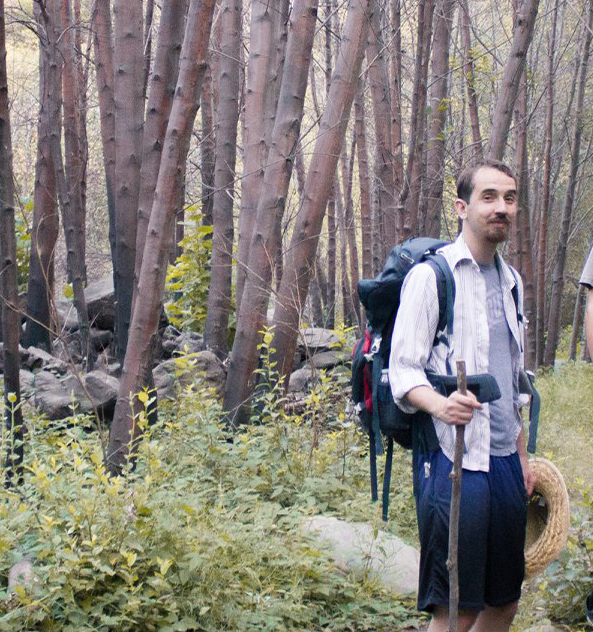Ten Tips for Hiking

A nyone who has ever been on a dating app can tell you that hiking is an extremely popular outdoor activity. Though hiking is well loved for a reason, there are many factors which can turn a dream hike into a disappointing slog. Over the years I have come up with the following tips in order to protect against subpar hiking experiences. These tips may just come in handy on your next excursion.
1. Don't Do Difficult Hikes At Night
All hiking paths exist somewhere on a spectrum. On one end of the spectrum, you have the hiking paths which are so clear and easy to follow, that you would have to actively work to get yourself lost on them. On the other end of the spectrum, you have the paths which are so difficult to follow that sometimes, the only way to tell that you are still on the path is by finding the occasional path marker. Hiking on paths from the latter end of the spectrum at night is both stressful and dangerous. To avoid this, be sure that you know when it gets dark and be sure to have something that will tell you the time. Plan to finish your hike before it gets dark. Getting lost in the dark is no fun. If there is a chance that you might have to hike after dark, be sure to bring a flashlight. An otherwise manageable hike can be downright frightening if you are on it at night.
2. Don't Bring Your Pet(s) On Difficult Hikes
This is a relatively new rule for me. My family has a beautiful dog named Wednesday. She’s a beloved member of the family. Recently, my brothers and I thought it would be a good idea to take Wednesday on our hike into Los Padres National Forest. We could not have been more wrong. Our path was a rocky one, with a river which we had to cross rather frequently. Dogs like Wednesday are not built for leaping from rock to rock. Dogs do not have boots to protect their feet from jagged or scorching hot stones. Some dogs like Wednesday hate getting into the water. Though Wednesday started the hike just fine, by the end of the hike, we were carrying her through huge stretches of path. She got cut on her right, hind paw and was exhausted for days afterwards. When we got back home we also found a tick right above her left eye. Though she has not exhibiting the signs of any tick borne pathogens, a single tick has the potential to pass on devastating diseases to pets. The bottomline is that pets can’t prepare themselves for a hike the way that you can. They also don’t know what they are getting into when you take them along with you on a hike, and they aren’t articulate enough to communicate their discomforts to you. If you are going on a long and difficult hike, leave your pet(s) at home!
3. Bring The Proper Footwear: Comfortable, Durable, Dirtiable
Hiking usually lasts a couple of hours at least: if your shoes are uncomfortable, you’re going to feel it eventually. When I was walking the Portuguese Camino, my shoes got so uncomfortable that I reached a point where I wasn’t able to put pressure on certain parts of my feet. Having to walk in a weird way to avoid searing pain in my foot took a lot of the fun out of the travel that day.
Furthermore, if your shoes are not durable, you can very easily waste a pair of shoes on a single hike. On my last trip to Los Padres, I went hiking in my everyday recreational shoes. By the end of the hike, my shoes had a hole in the side wide enough for me to fit my big toe through. I lost out on an otherwise fine pair of shoes because I didn’t make the right choice of footwear. Having the right shoes can make the difference between a great hike and an uncomfortable, overly expensive one. Hiking will ruin shoes which are not up to the task.
4. Know Your Poison Oak

During the time I spent at my alma mater — Thomas Aquinas College — I went on a hike just about every week. For a while though, my roommate and I were too lazy to look up what poison oak looked like. The result was itchy. Poison oak is not fun, and not knowing what it looks like or how to treat it can ruin your week. Poison oak has distinct looking leaves. This article contains an image of a poison oak leaf as a reference: take a mental picture! An excellent passive defense against poison oak is wearing pants or long socks. If you know that your skin has come into contact with poison oak, try to rinse the area with water as soon as possible. Most people do not react immediately to poison oak so you have a short window of time to rinse the area off. Once you’ve returned to civilization, follow up with a thorough rinsing of the area with soap and cold water. Keep a keen eye out for these plants and do your best to avoid contact. If you can point out a patch of poison oak to your friends, they will very often thank you for it. Even on well hiked paths it is common for poison oak leaves to extend right into the middle of the path.
5. Travel With People Who Are At A Similar Hiking Level
There are two major axis to consider when evaluating someone’s hiking level: cardiovascular endurance, and personal investment. In general, if you really love to hike and are able to hike for days, you probably want to hike with other people like yourself. If you’re only occasionally interested in hiking and don’t care for long excursions, hike with people who are similar to yourself. A person’s hiking level will affect their expectations about how far and how long they are willing to hike. If your expectations are not shared with the people you are hiking with, someone is going to be disappointed or upset. Be sure to talk with the people you plan to hike with beforehand. Get to know their intentions for hiking and see if their expectations match up with your own. Of equal importance, get to know your own hiking level. Many people have realized too late that they are physically unable to do the three day hike that they’ve committed to. Know your hiking level, and make sure that it lines up with that of your fellow hikers.
6. Take Your Time (Enjoy the Scenery/Take in the Sights)
Among the many reasons to hike, one of the most compelling reasons is to see the beauty of nature. Hilariously though, it is very easy to have the wrong sort of mindset and miss out on the beauty altogether. On one hike, my brothers and I were dedicated to seeing just how quickly we could arrive at a particular location. Though the hike was definitely enjoyable, at one point I had noticed that I had hardly stopped to take in the beauty of the nature around me. I still regret not having a more leisurely mentality on that hike. If you make your hike about the destination, you’ll very likely miss out on the journey.
7. Have Sun Protection
Like poison oak, sun damage is the kind of troubling consequence of hiking that can affect you long after the hike is over. This should be taken especially seriously given how deadly skin cancer can be. To avoid temporary or long term sun damage, be sure that all parts of your body are protected against the sun, especially your face, arms, and neck.
What’s that? You hate sunscreen? Me too! I can’t stand sunscreen! Sunscreen is sticky, stinky, and gross. Luckily, unlike swimming, hiking allows for all sorts of sun protection alternatives to sunscreen. Personally, I like wearing a collared shirt to protect my arms. If you use this method, be sure to pick a collared shirt with lightweight and breathable fabric.
I also usually wear a damp hand towel around my neck to protect the back of my neck from the sun. Finally, I usually top things off with a broad brimmed hat to protect my face. With this setup, I never have to wear sunscreen and I never suffer from sunburns or other sun related issues.
8. Bring The Appropriate Amount Of Water
When packing water for a trip, there are a few important things to take into account. First, know how much water you consume in general. When it comes to water consumption, I’m like a camel: during my last eight hour hike, I only ended up drinking one bottle of water. Everyone is different though and many hikers need one or two bottles of water every hour.
The second thing to consider is the context of the hike. Will you be doing most of your hiking around noon? Is there any shade on this path? How many hours do you expect to be hiking? The answers to these questions will go a long way to help you determine just how much water you will need.
The final thing to consider is whether your fellow hikers may eventually be in need of water. As a hiking enthusiast who does not tend to need much water and can carry quite a lot, I usually pack extra water bottles for friends. Inexperienced hikers will frequently err on the side of bringing too little water. Packing extra water can help keep the hike pleasant for everyone. More importantly, packing extra water can ensure that the hike is a safe experience for everyone.
Be wary however, while water is important for your health, it can also be one of the heaviest things in your backpack. Err on the side of having more water rather than less but don’t bring an absurd amount of water either. Finding the right balance is difficult and can take a lot of experience.
9. Be Ready To Get Your Feet Wet
This only applies to paths with a shallow river or stream. If your hike requires you to cross a river or stream, it can be really handy if you are willing to simply wade into it. On one of my favorite hiking paths, I’ll often save many stressful minutes of hoping from rock to rock by walking effortlessly through the water. On top of being efficient, walking through a stream can also be remarkably refreshing on hot days.
10. Your Backpack Will Feel Heavier As The Hike Goes On
It’s easy to want to overpack for hikes. I can’t even count the number of times that I’ve started off a hike thinking that my backpack was pleasantly light, only to feel overburdened by the end of the hike. Do not go by how heavy your backpack feels at first as a standard for whether you’ve overpacked. Most of the time, your backpack will feel considerably heavier by the end of a long hike. Instead, make sure that you are only bringing what you really need to enjoy yourself: hiking is a terrible time to read a book or throw a football.
11. (Bonus Tip) Bring Spare Clothes!
I’m not counting this tip with the others because this last tip is only useful for people like me. If you’re like me, nothing is worse than being stuck in stinky, sweaty clothes. Bringing a spare shirt — and even deodorant — is a convenient, lightweight solution to ensure that you don’t find yourself uncomfortably dirty. Wearing sweaty clothes is really uncomfortable so having a clean shirt can go a long way towards keeping the hike enjoyable. If you also like staying clean, don’t forget to bring those spare clothes!
There you have it: ten-ish tips for enjoyable hiking! Now go out there and hike! There’s a lot of world left to discover!



